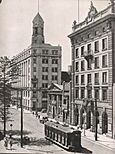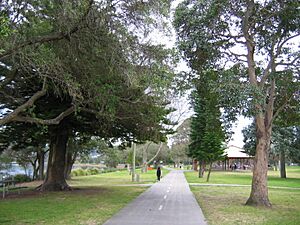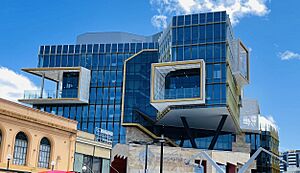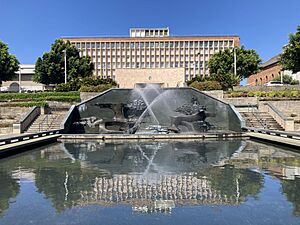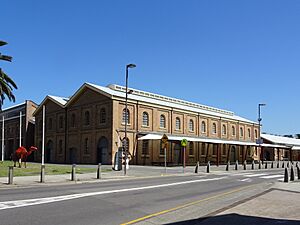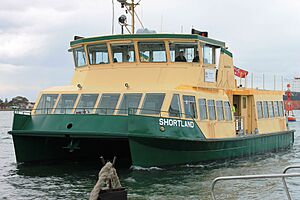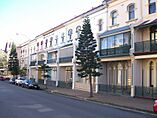Newcastle, New South Wales facts for kids
Quick facts for kids NewcastleNew South Wales |
|||||||||
|---|---|---|---|---|---|---|---|---|---|
|
Newcastle city centre
Light Rail on Hunter Street
|
|||||||||
| Population |
|
||||||||
| • Density | 431.208/km2 (1,116.82/sq mi) | ||||||||
| Established | 1804 | ||||||||
| Elevation | 9 m (30 ft) | ||||||||
| Area | 1,179.1 km2 (455.3 sq mi) | ||||||||
| Time zone | AEST (UTC+10:00) | ||||||||
| • Summer (DST) | AEDT (UTC+11:00) | ||||||||
| Location | |||||||||
| LGA(s) |
|
||||||||
| Region | Hunter | ||||||||
| County | Northumberland | ||||||||
| State electorate(s) |
|
||||||||
| Federal Division(s) | |||||||||
|
|||||||||
Newcastle, also known as Greater Newcastle or "Newy", is a large city area in New South Wales, Australia. It is the second biggest city area in New South Wales. Newcastle includes the cities of Newcastle and Lake Macquarie. It is also the main center for the Hunter Region, which includes parts of Maitland, Cessnock, and Port Stephens Council.
Newcastle is located where the Hunter River meets the ocean. It is famous for its coal. Newcastle has the largest coal exporting harbor in the world. In 2022, it shipped out 143 million tonnes of coal! The area around the city also has huge amounts of coal underground.
Contents
History of Newcastle
Who lived in Newcastle first?
The land where Newcastle and the lower Hunter Region are today was traditionally home to the Awabakal and Worimi Aboriginal people. They called this area Mulubinba.
Eight important landmarks in the area have been given official dual names. These names include both their European and traditional Aboriginal names. For example, Nobbys Head is also known as Whibayganba. The Hunter River (South Channel) is also called Coquun.
How Europeans settled Newcastle
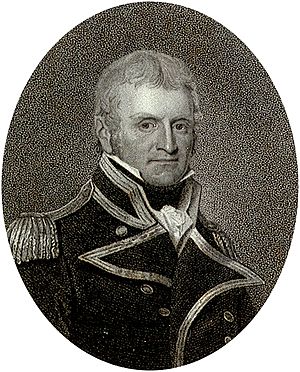
In September 1797, Lieutenant John Shortland was the first European to explore this area. He found it by accident while looking for some escaped prisoners. When he returned, he reported finding a "very fine river" which he named after the Governor of New South Wales, John Hunter. He also mentioned the deep-water port and lots of coal. For the next two years, coal from this area was the first export for the New South Wales colony.
Newcastle became a place where difficult prisoners were sent to dig for coal. This was a very strict punishment. In 1801, a camp called King's Town was set up to mine coal and cut timber. The first coal shipment was sent to Sydney that same year. However, this settlement closed less than a year later.
Another settlement was started in 1804. It was first called Coal River, then Kingstown, and finally Newcastle. It was named after the English city of Newcastle. Many coal miners from England came to this area later. You can still see this connection in place names like Jesmond, Hexham, and Wallsend.
Under Captain James Wallis, who was in charge from 1815 to 1818, things got better for the prisoners. Many new buildings were constructed. Captain Wallis planned the streets of the town. He also started building the breakwater that connects Nobbys Head to the mainland today. In 1816, the first school in Newcastle was built.
Newcastle remained a place for prisoners until 1822. After that, it was opened up for farming. Military rule ended in 1823. Most of the remaining prisoners were sent to Port Macquarie.
Newcastle from the 1920s to today

During World War II, Newcastle was a very important industrial center for Australia's war efforts. In 1942, a Japanese submarine briefly shelled Newcastle. It hit areas like the dockyards and the Newcastle Steelworks. Luckily, no one was hurt, and the damage was small.
The Port of Newcastle is still very important for the economy of the Hunter Valley. It is the world's largest port for exporting coal. It is also Australia's oldest port and the second busiest by weight of goods moved. Environmental groups like Rising Tide Australia are against increasing coal exports. They have held protests, including a large water blockade in 2023.
Newcastle used to have a big shipbuilding industry. However, the era of heavy industry mostly ended when the steel works closed in 1999. Many factories that are still around have moved away from the city center.
Newcastle has one of Australia's oldest theater areas. The Victoria Theatre on Perkins Street is the oldest theater built just for shows in the country. The city center has seen new apartments and hotels built recently. However, many businesses have moved to other areas. The main business district is now moving west towards a new development called "Honeysuckle".
The old city center still has many historic buildings. These include Christ Church Cathedral, Fort Scratchley, the Ocean Baths, the old Customs House, and the 1920s City Hall.
Geography of Newcastle
Newcastle is on the southern side of the Hunter River mouth. The northern side has sand dunes and swamps. A "green belt" of plants and wildlife protects the city from the west to the north. Most of the city's buildings are on the hilly southern side. The small town of Stockton is across the river from central Newcastle. You can get there by ferry or by driving 20 km (12 mi) over the Stockton Bridge.
Much of the city is built over coal deposits. Many small coal-mining villages that used to be in the hills have now joined together into one large city area. This area stretches south to Lake Macquarie. Greater Newcastle is located between the Central Coast and Mid North Coast regions.
Parks and green spaces
Newcastle has several public parks. One of these is King Edward Park, which was created in 1863. It offers great coastal views, a special sunken garden, and a Victorian rotunda.
Another notable park is Starrett Park in New Lambton. It is well-known for its playground and lovely green grass.
What is Newcastle's climate like?
Newcastle has a humid subtropical climate. This means it has warm, humid summers and mild winters. The Pacific Ocean helps to keep the weather from getting too extreme. Summers are generally warm and humid. Sometimes, hot, dry winds can bring temperatures over 40 °C (104 °F). The hottest temperature ever recorded was 42.5 °C (108.5 °F) in January 2013.
Winters are usually mild and drier than summer. Cold fronts can bring strong winds, but they often lead to clear skies. The lowest temperature ever recorded was 1.8 °C (35.2 °F) in July 1986. Sometimes, strong storms called "east coast lows" hit Newcastle. They can bring winds over 100 km/h (62 mph) and very heavy rain.
| Climate data for Newcastle (Nobbys Signal Station AWS), New South Wales, Australia (1991–2020 normals, 1862–present extremes); 33 m AMSL | |||||||||||||
|---|---|---|---|---|---|---|---|---|---|---|---|---|---|
| Month | Jan | Feb | Mar | Apr | May | Jun | Jul | Aug | Sep | Oct | Nov | Dec | Year |
| Record high °C (°F) | 42.5 (108.5) |
40.9 (105.6) |
39.0 (102.2) |
36.8 (98.2) |
28.5 (83.3) |
26.1 (79.0) |
26.3 (79.3) |
29.9 (85.8) |
34.4 (93.9) |
36.7 (98.1) |
41.0 (105.8) |
42.0 (107.6) |
42.5 (108.5) |
| Mean daily maximum °C (°F) | 25.7 (78.3) |
25.6 (78.1) |
24.8 (76.6) |
23.3 (73.9) |
20.7 (69.3) |
18.3 (64.9) |
17.8 (64.0) |
19.0 (66.2) |
21.1 (70.0) |
22.6 (72.7) |
23.3 (73.9) |
24.7 (76.5) |
22.2 (72.0) |
| Mean daily minimum °C (°F) | 20.1 (68.2) |
20.1 (68.2) |
18.8 (65.8) |
15.9 (60.6) |
12.7 (54.9) |
10.6 (51.1) |
9.4 (48.9) |
10.1 (50.2) |
12.6 (54.7) |
15.0 (59.0) |
16.8 (62.2) |
18.7 (65.7) |
15.1 (59.1) |
| Record low °C (°F) | 12.0 (53.6) |
10.3 (50.5) |
11.1 (52.0) |
7.4 (45.3) |
4.7 (40.5) |
3.0 (37.4) |
1.8 (35.2) |
3.3 (37.9) |
5.0 (41.0) |
6.5 (43.7) |
7.2 (45.0) |
11.0 (51.8) |
1.8 (35.2) |
| Average precipitation mm (inches) | 70.2 (2.76) |
109.7 (4.32) |
113.5 (4.47) |
109.0 (4.29) |
116.4 (4.58) |
125.2 (4.93) |
69.1 (2.72) |
49.4 (1.94) |
56.9 (2.24) |
62.0 (2.44) |
79.3 (3.12) |
67.9 (2.67) |
1,034.5 (40.73) |
| Average precipitation days (≥ 1.0 mm) | 7.1 | 7.9 | 8.9 | 8.2 | 8.9 | 9.0 | 7.6 | 5.4 | 6.3 | 6.9 | 8.3 | 7.7 | 92.2 |
| Average afternoon relative humidity (%) | 74 | 77 | 73 | 68 | 66 | 64 | 59 | 55 | 59 | 65 | 71 | 72 | 67 |
| Average dew point °C (°F) | 18.1 (64.6) |
18.9 (66.0) |
17.6 (63.7) |
14.7 (58.5) |
12.2 (54.0) |
9.6 (49.3) |
7.8 (46.0) |
7.6 (45.7) |
9.5 (49.1) |
12.5 (54.5) |
14.6 (58.3) |
16.7 (62.1) |
13.3 (56.0) |
| Source 1: Bureau of Meteorology (temperature, precipitation, humidity 1991–2020 normals) | |||||||||||||
| Source 2: Bureau of Meteorology (temperature extremes 1862–present) | |||||||||||||
| Climate data for Newcastle University – 8.5 kilometres (5 mi) WNW of Newcastle CBD, New South Wales, Australia (1998–2021 normals and extremes); 21 m AMSL | |||||||||||||
|---|---|---|---|---|---|---|---|---|---|---|---|---|---|
| Month | Jan | Feb | Mar | Apr | May | Jun | Jul | Aug | Sep | Oct | Nov | Dec | Year |
| Record high °C (°F) | 44.9 (112.8) |
44.0 (111.2) |
39.2 (102.6) |
34.5 (94.1) |
28.8 (83.8) |
25.7 (78.3) |
25.5 (77.9) |
30.5 (86.9) |
35.0 (95.0) |
37.9 (100.2) |
42.2 (108.0) |
43.0 (109.4) |
44.9 (112.8) |
| Mean daily maximum °C (°F) | 29.5 (85.1) |
28.4 (83.1) |
26.8 (80.2) |
24.1 (75.4) |
21.2 (70.2) |
18.4 (65.1) |
17.9 (64.2) |
19.8 (67.6) |
22.8 (73.0) |
25.0 (77.0) |
26.2 (79.2) |
27.9 (82.2) |
24.0 (75.2) |
| Mean daily minimum °C (°F) | 19.6 (67.3) |
19.4 (66.9) |
17.5 (63.5) |
14.0 (57.2) |
10.4 (50.7) |
8.8 (47.8) |
7.3 (45.1) |
7.9 (46.2) |
10.8 (51.4) |
13.4 (56.1) |
15.9 (60.6) |
18.0 (64.4) |
13.6 (56.4) |
| Record low °C (°F) | 11.2 (52.2) |
12.3 (54.1) |
9.6 (49.3) |
4.0 (39.2) |
3.5 (38.3) |
2.1 (35.8) |
1.0 (33.8) |
1.8 (35.2) |
4.2 (39.6) |
5.4 (41.7) |
7.0 (44.6) |
8.7 (47.7) |
1.0 (33.8) |
| Average precipitation mm (inches) | 81.3 (3.20) |
135.5 (5.33) |
125.2 (4.93) |
118.1 (4.65) |
87.5 (3.44) |
131.9 (5.19) |
64.1 (2.52) |
57.1 (2.25) |
66.2 (2.61) |
68.2 (2.69) |
102.3 (4.03) |
71.6 (2.82) |
1,111.2 (43.75) |
| Average precipitation days (≥ 1.0 mm) | 7.5 | 9.2 | 9.0 | 8.2 | 7.7 | 9.3 | 7.1 | 6.1 | 6.0 | 6.5 | 8.7 | 7.3 | 92.6 |
| Average afternoon relative humidity (%) | 57 | 62 | 60 | 61 | 59 | 60 | 54 | 48 | 48 | 50 | 58 | 58 | 56 |
| Average dew point °C (°F) | 17.2 (63.0) |
18.2 (64.8) |
16.3 (61.3) |
13.5 (56.3) |
10.4 (50.7) |
8.5 (47.3) |
6.5 (43.7) |
6.0 (42.8) |
8.3 (46.9) |
10.4 (50.7) |
14.2 (57.6) |
16.1 (61.0) |
12.1 (53.8) |
| Source: Bureau of Meteorology (temperature, precipitation, humidity) (1998–present normals and extremes) | |||||||||||||
| Newcastle Water Temperature | |||||||||||||
|---|---|---|---|---|---|---|---|---|---|---|---|---|---|
| Month | Jan | Feb | Mar | Apr | May | Jun | Jul | Aug | Sep | Oct | Nov | Dec | Year |
| Average sea temperature °C (°F) | 23.6 (74.5) |
24.0 (75.2) |
23.9 (75.0) |
22.9 (73.2) |
21.6 (70.9) |
20.1 (68.2) |
19.2 (66.6) |
18.9 (66.0) |
19.1 (66.4) |
19.4 (66.9) |
21.0 (69.8) |
22.6 (72.7) |
21.3 (70.4) |
| Source #2: Metoc (sea temperature) | |||||||||||||
People of Newcastle
The Newcastle city area is the second most populated place in New South Wales, after Sydney.
The 'Greater Newcastle Area' includes several local government areas. These are Newcastle, Lake Macquarie, Maitland, Cessnock, and Port Stephens. In 2021, this whole region had a population of 682,465 people.
Most people in the Newcastle area, about 83.6%, were born in Australia. Other common birthplaces include England, New Zealand, and China. About 3.8% of the population are Aboriginal and Torres Strait Islander people. Most people, 88.2%, speak only English at home.
People from Newcastle are called "Novocastrian". This name comes from Latin words meaning "new" and "castle" or "fort".
Newcastle's Economy

Newcastle used to be a big center for heavy industry. This meant it was hit hard when the economy slowed down in the 1970s and beyond. In the early 1990s, many jobs were lost across Australia. Newcastle's unemployment rate reached 17% in 1993.
In 1999, the steelworks closed after 84 years. It had employed about 50,000 people over its lifetime. Even though the steelworks closed, Newcastle's economy started to change and become more diverse. This made the local economy stronger.
Since 2003, Australia has seen a boom in prices for goods like coal. This led to a lot of investment in the Newcastle and Hunter region. This is because it is a major hub for coal mining and exporting to Asian countries. Large projects related to coal helped Newcastle's unemployment rate drop to its lowest in 20 years. This also helped the region deal with the effects of the late 2000s economic slowdown better than other parts of New South Wales.
Today, the two biggest employers are the Hunter New England Area Health Service and the University of Newcastle.
Early industries in Newcastle
Coal mining in Newcastle

Coal mining really started in Newcastle on May 3, 1833. The Australian Agricultural Company was given land and a 31-year monopoly on coal transport in the town. Other coal mines were located nearby. These included mines at Stockton, Tighes Hill, and Carrington. All these operations closed by the early 1960s.
On December 10, 1831, Australia's first railway officially opened in Newcastle. It was privately owned and used to serve the 'A Pit' coal mine.
Copper and other industries
In the 1850s, a large copper smelting factory was built at Burwood, near Merewether. Later, other copper works were built at Broadmeadow and Cockle Creek Smelter.
A huge soap factory was built in 1885 by Charles Upfold. It was the largest of its kind in the Southern Hemisphere. His company, Sydney Soap and Candle Company, won many awards for its products. After World War I, the company was sold, and the factory closed in the mid-1930s.
Steel production
In 1911, BHP chose Newcastle for its steelworks because there was so much coal. The land chosen was right on the harbor. In 1915, the Newcastle Steelworks opened. For about 80 years, it was a major part of the steel and heavy industry. It became the biggest employer in the region.
Education in Newcastle
Schools for all ages
Newcastle High School was formed by combining three schools. Its history goes back to a secondary school section that started at Newcastle East Public School.
There are also three special state schools in the area:
- Hunter School of the Performing Arts: This school is for students from Years 3 to 12. Students are accepted only after an audition.
- Merewether High School: This is a fully selective high school in the suburb of Broadmeadow.
- Hunter Sports High School: This school is partially selective for sports. About half its students are from the local area, and the other half are chosen by audition.
The two main independent schools in Newcastle are Newcastle Grammar School and St Philip's Christian College. Both schools teach students from kindergarten to Year 12.
Universities and colleges
The main place for higher education in Newcastle is the University of Newcastle. It started in 1951 as a branch of the University of New South Wales. It became its own university in 1965. Now, it offers over 150 courses to more than 38,000 students. About 7,000 of these students come from over 113 different countries. The main campus is in Callaghan, about 12 km (7 mi) from the city center.
There are also three campuses of the Hunter Institute of TAFE. These are located in the Newcastle CBD, Hamilton East, and Tighes Hill. The Tighes Hill campus is the largest and offers courses in business, hospitality, and various trades.
Culture in Newcastle
Newcastle hosts many cultural events and festivals throughout the year.
The Newcastle Regional Show happens every year at the Newcastle Showground. It has typical fair activities like woodchopping, showbags, rides, and stalls. There are usually fireworks too.
The Mattara festival started in 1961. It is Newcastle's official festival. It includes a parade, rides, sports events, and art exhibitions. "Mattara" means "hand of friendship" in the local Awabakal language.
The Newcastle Jazz Festival takes place over three days in August. It brings together performers and audiences from all over Australia.
This Is Not Art is a national festival for new media and arts. It is held in Newcastle every October. It started in 1998 and is now one of Australia's top arts festivals. It includes other festivals like Electrofringe and the National Young Writers' Festival.
The Newcastle Entertainment Centre is a popular place for events like concerts and monster truck shows.
Music scene
Newcastle has a lively music scene, especially for young people. It also has a Conservatorium of Music, which is part of the University of Newcastle. Many successful Australian bands come from Newcastle, including Silverchair, The Screaming Jets, and Vacations (band). Danielle Marsh, a member of the famous South Korean K-pop girl group New Jeans, is also from Newcastle.
Art and galleries
The Newcastle Art Gallery has one of Australia's most important public art collections outside of a major capital city. It has many works by Australian artists, both old and new. The Lock Up is a modern art space in the city. It shows art from local, national, and international artists.
Theatres in Newcastle
Newcastle has several smaller theaters. The main theater in the city center is the Civic. It was built in 1929 in the Art Deco style and can seat about 1,500 people. It hosts many musicals, plays, concerts, and dance shows.
Newcastle used to have other large theaters, like the Victoria Theatre. This was the oldest theater in Australia built just for shows. It hosted famous stars like Dame Nellie Melba. Many theaters closed from the 1960s onwards, partly because of television.
Many famous Australian actors and comedians are from Newcastle. These include Sarah Wynter, John Doyle, and Susie Porter. The cast of the Tap Dogs show also comes from Newcastle.
Museums and libraries
The Newcastle Museum opened in 1988. It tells the story of local history, culture, industry, and science. It has exhibits about coal mining, steel production, and Aboriginal history.
Newcastle has a public library system called Newcastle Libraries. The main library is in the Newcastle War Memorial and Cultural Centre. There are also eleven branch libraries around the city. The library has a special collection of old newspapers, films, and historical documents.
The Auchmuty Library at the University of Newcastle is also open to the public.
Getting around Newcastle
Like most big cities, Newcastle has many roads and public transport options like buses and taxis. These cover most areas of Newcastle and Lake Macquarie. Train services are available along major routes. Ferry services connect Newcastle and Stockton. Most people in the city use cars to get around.
Newcastle used to have a tram system, but it closed in 1950. However, trams returned to the city in February 2019 with the opening of the Newcastle Light Rail.
Roads in Newcastle
Newcastle is connected to nearby cities by major roads. These include the Pacific Motorway (to the south), Hunter Expressway (to the west), and the Pacific Highway (north and south). Hunter Street is the main shopping street in central Newcastle.
Bus services
Bus services within Newcastle are run by Newcastle Transport. Buses start from a main terminal at Newcastle Interchange. There are also major bus stops at the University of Newcastle, Wallsend, and Charlestown Square.
Long-distance bus services also connect Newcastle to other parts of Australia.
Train services
The Newcastle area has two NSW TrainLink intercity lines. These provide local and regional services that end at Newcastle Interchange. The Central Coast & Newcastle Line has trains to Sydney and the Central Coast twice an hour. The Hunter Line has trains to Maitland and other towns.
Two long-distance train lines also pass through Broadmeadow station. These go to places like Moree, Armidale, and Brisbane.
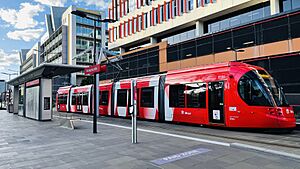
Newcastle used to have more train lines to towns like Belmont and Toronto, but these have closed. In 2014, the train line into central Newcastle was shortened. A new Newcastle Interchange opened in 2017. The Newcastle Light Rail line also starts from here.
Water transport
The Port of Newcastle is very important for the economy of Newcastle and the Hunter Valley. More than 90 million tonnes of coal are shipped through it each year. This makes it the largest coal exporting port in the world. Coal was first exported from the harbor in 1799.
Newcastle Transport also runs a ferry service across the Hunter River. It connects Newcastle's city center with Stockton.
Air travel
Newcastle Airport is about 15 km (9 mi) north of central Newcastle. The airport has grown quickly since 2000. It is located at RAAF Base Williamtown, which is a Royal Australian Air Force base.
The Westpac Life Saver Rescue Helicopter Service is based in Broadmeadow. This helicopter service is one of the oldest in the world. Two helicopters operate from this base 24 hours a day.
Sports in Newcastle
Rugby league
Rugby league is the most popular sport in Newcastle. The Newcastle Knights team represents the city in the National Rugby League. They play at the McDonald Jones Stadium, which can hold 33,000 people.
The Newcastle Rugby League holds local club competitions. The Newcastle & Hunter Rugby League is a community competition. It is the largest community rugby league competition in the world.
McDonald Jones Stadium hosted a big international game in 2016 between Australia and New Zealand.
Soccer
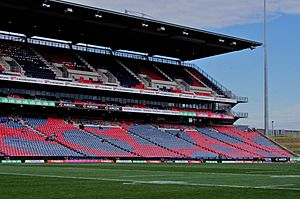
The Newcastle Jets Football Club plays in Australia's top soccer league, the A-League. They also play at McDonald Jones Stadium. The Newcastle Jets won the A-League championship in their third season.
The city also hosted four games of the 2015 AFC Asian Cup, including a semi-final match.
Basketball
Newcastle has had two teams in Australia's top men's basketball league, the National Basketball League. These were the Newcastle Falcons and later the Hunter Pirates. Both teams stopped playing due to money problems. Newcastle still has teams in the second-tier league, the NBL1.
Other sports
- Cricket: Newcastle tried to get a team in the national Twenty20 cricket competition, the Big Bash League, but it was not successful.
- Australian Rules Football: This sport is played in Newcastle and managed by AFL Hunter Central Coast.
- Rugby Union: Rugby union has been played in Newcastle since at least 1869. The Newcastle and Hunter Rugby Union oversees the sport in the region.
- Horse Racing: Broadmeadow Racecourse is home to the Newcastle Jockey Club. They hold races many times a year.
- Ice Hockey: The Newcastle North Stars play in the Australian Ice Hockey League. They play at the Hunter Ice Skating Stadium.
- Motorsport: Newcastle hosted the final round of the Supercars Championship in 2017. The Newcastle 500 race is held on a street circuit in the city.
- Water Sports: Newcastle has many beaches and surf spots. It hosts the annual surfing contest Surfest. Four-time world champion surfer Mark Richards grew up surfing at Merewether Beach. Nobbys Beach is popular for kitesurfing.
Media in Newcastle
Newcastle has a daily newspaper called The Herald. There are also several weekly newspapers like the Newcastle Star.
The city also has many local radio stations, including those from the Australian Broadcasting Corporation (ABC) and SBS.
- AM stations: 2HD (commercial), Radio 1629 Newcastle.
- FM stations: Triple M Newcastle (commercial), hit106.9 Newcastle (commercial), New FM (commercial), 2NUR (community), Rhema FM Newcastle (Christian).
- Government broadcasters: ABC Newcastle (local radio), ABC Radio National, ABC NewsRadio, Triple J (youth station), ABC Classic FM (classical music), SBS Radio (foreign-language service).
Newcastle is also served by five television networks:
- Nine Northern NSW
- WIN Television's 10 Northern NSW
- Seven Northern NSW
- ABC Television
- SBS Television
Nine airs NBN News live from its studios every night. This news program combines local stories with national and international news.
Major Events and Disasters
1989 Newcastle earthquake
On December 28, 1989, Newcastle had an earthquake. It measured 5.6 on the Richter scale. The earthquake killed 13 people and injured 162. Many important buildings were damaged or destroyed. Some had to be torn down. The city took several years to recover. However, Beaumont Street in Hamilton, which was badly damaged, became a lively area with many restaurants after the earthquake.
June 2007 storms
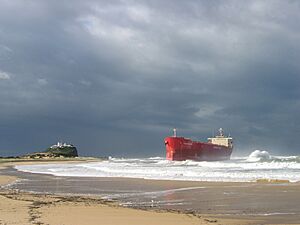
On June 8, 2007, the Hunter and Central Coast regions were hit by very bad storms. These storms caused a lot of flooding and nine deaths. Thousands of homes were flooded, and many were destroyed. The areas were declared natural disaster areas.
During the storms, a large ship called the Pasha Bulker ran aground at Nobbys Beach. It had not listened to warnings to move away from the shore. After several tries, the ship was finally refloated on July 2, 2007.
Maritime accidents
Newcastle has a long history of shipwrecks. On July 12, 1866, a paddle steamer called the SS Cawarra sank in a storm while leaving the harbor. Sixty people died.
The worst maritime accident in Newcastle in the 20th century happened on August 9, 1934. The ferry Bluebell crashed with a freighter called Waraneen and sank in the Hunter River. Three people died, and fifteen passengers were taken to the hospital. It was later found that the ferry captain was at fault.
Aviation accident
On August 16, 1966, an RAAF CAC Sabre plane crashed into the inner-city suburb of The Junction. The pilot had engine problems and tried to get the plane over the ocean, but he couldn't. Most of the plane wreckage landed in the shopping area. A memorial plaque was put up in 2007 for the pilot who died.
Buildings and Architecture
Newcastle has many buildings that are listed for their historical importance. These include:
- Argyle House on Argyle Street
- David Cohen & Co. Warehouse on Bolton Street
- Old Newcastle East Public School on Bolton Street
- Coutt's Sailors Home on Bond Street
- Newcastle Customs House on Bond Street
- Newcastle Reservoirs on Brown Street
- Church and Watt Street Terrace Group on Church Street
- Newcastle Court House on Church Street
- Honeysuckle Point Railway Workshops
- Newcastle railway station
- The Ridge on Hillcrest Road
- T & G Mutual Life Assurance Building on Hunter Street
- Newcastle Post Office on Hunter Street
- Frederick Ash Building on Hunter Street
- Newcastle City Hall on King Street
- Nesca House on King Street
- Miss Porter's House on King Street
- Coal River Precinct on Nobby's Road
- Old Newcastle Club Building on Pacific Street
- Victoria Theatre on Perkins Street
- Great Northern Hotel on Scott Street
- Convict Lumber Yard on Scott Street
- Bogey Hole on Shortland Esplande
- Shepherds Hill military installations on The Terrace
- Manufacturers House on Watt Street
- Newcastle Government House on Watt Street
Sister Cities
Newcastle has "sister city" relationships with other cities around the world. This helps promote cultural exchange and understanding.
 Newcastle upon Tyne, United Kingdom
Newcastle upon Tyne, United Kingdom Pohang, North Gyeongsang, South Korea
Pohang, North Gyeongsang, South Korea Ube, Yamaguchi, Japan
Ube, Yamaguchi, Japan Arcadia, California, United States
Arcadia, California, United States
See also
 In Spanish: Newcastle (Australia) para niños
In Spanish: Newcastle (Australia) para niños










